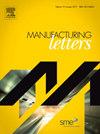3D soft material printer as a mesoscale additive biomanufacturing platform for in-space manufacturing
IF 1.9
Q3 ENGINEERING, MANUFACTURING
引用次数: 0
Abstract
With the burgeoning in-space manufacturing (ISM) industry, developing an on-demand additive manufacturing (AM) platform will be crucial for long-term space habitation. However, acute space boundary conditions, such as limited physical space, microgravity, vacuum, and others pose unique challenges for designing the printing process, the platform’s structure, and the materials’ printability. An AM platform operable in a space environment would enable production at the point of need (PoN), for example, on-demand food, nutrition, and pharmaceutical products. This research is focused on the design, fabrication, and testing of a 3D printer confined within CubeSat boundaries to study the feasibility of soft material printing aimed toward potential ISM applications. The printer unit was built using components off the shelf (COTS) while adhering to the severe spatial boundary conditions posed by the CubeSat dimensions and was tested using an edible material ink to demonstrate multi-layer prints of soft materials. Printing in ambient Earth conditions as well as under vacuum displayed consistent layer cohesion and comparison to 3D model data although vacuum prints showed visibly dehydrated prints owing to outgassing of air bubbles. The printer equipment’s structural integrity was validated under simulated launch and operation conditions using a vibration testing setup according to the NASA-recommended microsatellites standards. The results indicated that the printer assembly maintained its structural and operational integrity during and after testing. Using soft materials as the basis of testing allows scalability when expanding to more complex and structural materials to produce spare parts using a frugally engineered modular manufacturing platform.
三维软材料打印机作为用于太空制造的中尺度增材生物制造平台
随着太空制造(ISM)产业的蓬勃发展,开发按需增材制造(AM)平台对长期太空居住至关重要。然而,有限的物理空间、微重力、真空等严峻的空间边界条件对打印工艺、平台结构和材料的可打印性设计提出了独特的挑战。可在太空环境中运行的 AM 平台可实现按需生产(PoN),例如按需生产食品、营养品和药品。这项研究的重点是设计、制造和测试限制在立方体卫星边界内的三维打印机,以研究软材料打印的可行性,从而实现潜在的国际空间站应用。该打印机使用现成组件(COTS)制造,同时遵守立方体卫星尺寸所带来的严格空间边界条件,并使用可食用材料墨水进行测试,以演示软材料的多层打印。在地球环境和真空条件下进行的打印显示出一致的层内聚力,并与三维模型数据进行了比较,但真空打印因气泡排出而显示出明显的脱水打印。根据美国国家航空航天局推荐的微型卫星标准,使用振动测试装置在模拟发射和运行条件下验证了打印机设备的结构完整性。结果表明,打印机组件在测试期间和测试之后都保持了结构和运行的完整性。使用软材料作为测试的基础,在扩展到更复杂的结构性材料时具有可扩展性,可利用节俭的工程模块化制造平台生产备件。
本文章由计算机程序翻译,如有差异,请以英文原文为准。
求助全文
约1分钟内获得全文
求助全文
来源期刊

Manufacturing Letters
Engineering-Industrial and Manufacturing Engineering
CiteScore
4.20
自引率
5.10%
发文量
192
审稿时长
60 days
 求助内容:
求助内容: 应助结果提醒方式:
应助结果提醒方式:


